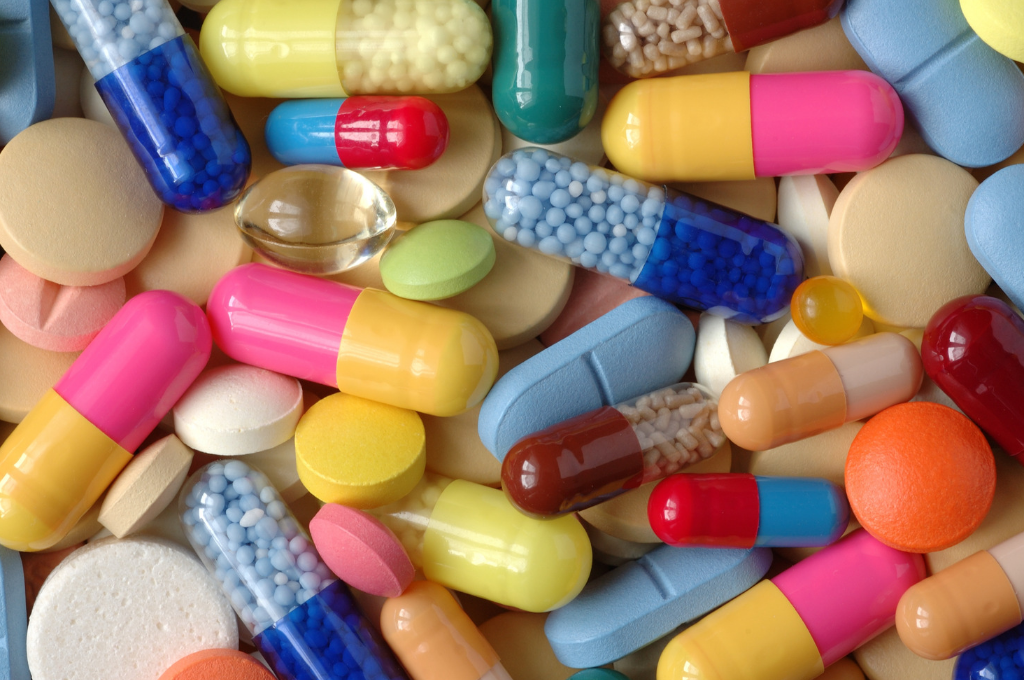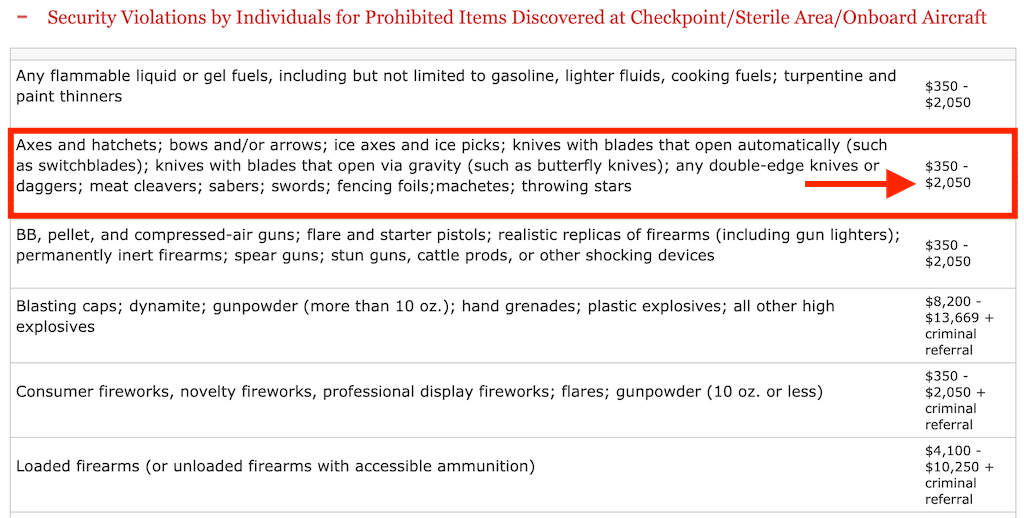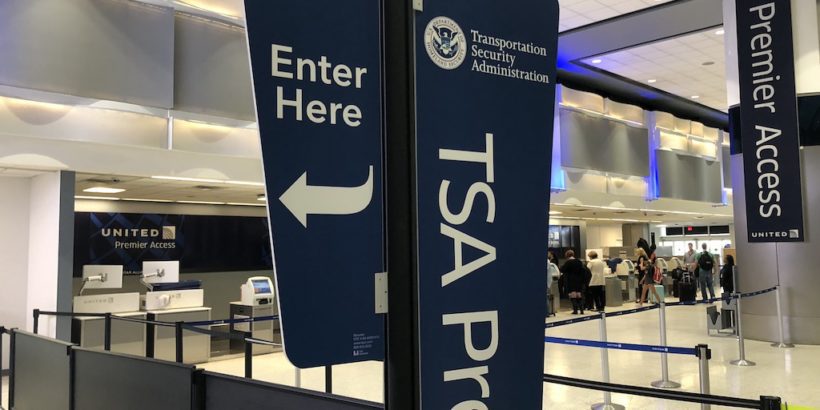Getting your carry-on bag through TSA security requires you to abide by a number of rules. Some of these are (hopefully) pretty obvious like not bringing a gun through security but others are more subtle like what constitutes a liquid and are there exceptions for medication?
In this article, I will cover the 11 TSA carry-on rules that really matter the most.
Table of Contents
Show a valid ID to proceed
Before you ever get a chance to take your carry-on luggage through the TSA airport security checkpoint, you first need to show a valid ID and your boarding pass.
TSA accepts a lot of different types of ID and even if you forgot or lost your ID, there is still a way for you to get through (you just will need extra time in that case).
Tip: Use the free app WalletFlo to help you travel the world for free by finding the best travel credit cards and promotions!
TSA Pre-Check exemptions
If you have TSA Pre-Check the rules for transporting your carry-on will be a little bit different. TSA Pre-Check allows you to bypass the main security line and head to a line that is usually shorter and faster. Not only do you get to access the expedited security checkpoint, but you also get the following benefits:
- Shoes can stay on
- Belt can stay on
- Light jackets can stay on
- Laptops allowed to stay in bag
- Liquids (3-1-1 Rule) can stay in bag
The last two benefits are the ones that really affect how you get your carry-on through security. The first major difference is that you can keep your large electronics such as laptops in the carry-on.
The second major difference relates to bringing liquids in your carry-on which I will talk about next.
Related: CLEAR Airport & Stadium Security Review
Liquids (3-1-1 Rule)
Probably the most well-known TSA carry-on rule is the liquids rule which is also known as the “3-1-1 rule.”
- The “three” indicates that your liquids must be contained within a container no larger than 3.4 fluid ounces or (100 mL)
- The first “one” means that your liquids must fit within 1 quart-sized resealable bag
- The last requirement is that you are allowed 1 quart size bag per person
If you have TSA Pre-Check then you do not have to remove your quart sized bag from your carry-on. However, if you are traveling with a standard boarding pass then you will need to remove this bag from your carry-on as you make your way through security.
Knowing how to store your liquids in a bag is pretty easy but the much more difficult question sometimes is what actually is considered a liquid?
Many personal items like deodorant, toothpaste, and other toiletries can fall into a bit of a gray area. It really just comes down to the type of state they are in.
If they are in a gel-like state that is typically going to be considered a liquid but if they are in more of a solid state (like deodorant often is) then that should be considered a solid.
Note, in 2021, there was an accidental publication about TSA allowing bigger quantities of sunscreen to go through but that is no longer the case. Sunscreen in your carry-on is still subject to the standard TSA liquids rule.
Foods allowed but need to be packaged
What foods can be brought in your carry-on item through TSA airport security is one of the most common travel questions related to TSA that I see and hear. Many travelers are pretty surprised to find out that they can bring along a lot of different types of food with them through security and on the plane.
For the most part, you can bring reasonable quantities of just about any type of solid food you can think of. The key thing to keep in mind is that you may have to remove your food from your carry-on for x-ray scanning. So it is really smart to properly package up your food so that things don’t get messy and you don’t slow down the security line.
It gets a little tricky when it comes to food that is in a liquid or semi-liquid state. In those cases, the food will be treated as a liquid which means that it will be subject to the 3-1-1 Rule.
Here is a non-exhaustive list of food items that will fall under the liquids rule:
- Liquid chocolate
- Creamy dips and spreads
- Mashed fruits such as applesauce
- Gravy
- Honey
- Jam and jelly
- Maple syrup
- Oils and vinegars
- Peanut butter
- Wet pet food
- Salad dressing
- Salsa and sauces
- Soups
- Yogurt
Alcohol allowed but within limits
Alcohol has its own set of unique rules when it comes to airport security. You are allowed to bring alcohol with you on a plane as long as you comply with TSA 3-1-1 rule and also FAA rules.
Passengers are permitted to bring in mini bottles of alcohol but they must fit in the quart-sized bag. This also means that you can bring along your own alcohol as long as the alcohol is in a container no greater than 3.4 ounces.
Alcoholic beverages with more than 70% alcohol (over 140 proof), including grain alcohol and 151 proof rum are not allowed on the plane. That’s because alcohol becomes flammable at that level.
Keep in mind that there are special rules for consuming alcohol on a plane so make sure that you read more about bringing alcohol on a plane.
Medication exceptions
TSA is pretty relaxed about medication in carry on bags. They allow you to go beyond the requirements of the liquids rule so long as you are bringing reasonable quantities of your medication in your carry-on.
They also don’t check your medication for prescriptions (although you should be aware that state laws still apply regarding controlled substances).
So for the most part as long as you are being reasonable with the quantities of medication you will need on your trip and you are able to articulate that to a TSA agent, you should not have issues with bringing medication in your carry-on.

Sharp objects banned
A common point of confusion relates to bringing sharp objects through TSA in carry-on bags. You are allowed to bring certain types of sharp objects but they usually need to be pretty small and not very threatening. For example, you can bring small scissors, round-bladed butter knives, disposable razors, tweezers, etc.
The penalties for bringing a knife in your carry-on can be quite stiff. For example, you could get hit with up to a $2,050 fine if you’re caught with a knife since they fall in the banned category below:
Axes and hatchets; bows and/or arrows; ice axes and ice picks; knives with blades that open automatically (such as switchblades); knives with blades that open via gravity (such as butterfly knives); any double-edge knives or daggers; meat cleavers; sabers; swords; and machetes throwing stars
So leave the sharp objects in your checked baggage and be sure to properly package them so that sharp tips are not exposed to someone who might need to search through your bag.

Explosives and flammable substances
It’s probably obvious to 99% of the population that you should not bring explosives on a plane and that you will not be able to bring them through TSA inside your carry-on luggage.
There is some confusion though because some items can be considered explosives that you may not necessarily think about.
For example, there are batteries that can explode given the right conditions and there are other flammable substances that come in products like bear spray. My advice would be to check the list of flammables provided by the TSA.
Firearms never allowed
Firearms are never permitted to be brought in your carry-on. TSA will find these when your carry-on bag goes through the x-ray machine and they may refer you to authorities who could then press charges on you. So make sure that you are aware of how to properly travel with your firearms via aircraft.
Size doesn’t necessarily matter
TSA is not very concerned about the size of your carry-on.
In fact, you can find a lot of reports online of people bringing some very large carry-on bags through security that are obviously too big for an airline to accept. This was actually a pretty well-known travel hack that more airlines are probably aware of than ever before.
For the most part, if your carry-on bag can fit through the x-ray machine chances are TSA is not going to raise an issue. I’m sure some agents are more vigilant about these things but many will probably let an oversized bag slide as long as it does not cause issues for security screening.
Since TSA does not make up the rules regarding the size of your carry-on bag, you need to check with the baggage policy of your airline to ensure that your bag is within the size limits.
Every airline will have published size limits but they are not always enforced so there often is a little bit of leeway.
Also, a lot of airlines do not publish the weight requirements for a carry-on bag so you typically can get away with pretty heavy carry-ons (within reason).
SSSS = more security screening
If your boarding pass happens to have four capital S’s (“SSSS”), this means that you are going to be subjected to enhanced security screening.
Most likely you will have to open up your carry-on bag and allow a TSA agent to dig through all of your belongings and possibly remove them for inspection.
Sometimes this process is a major pain but other times it is not so bad.
It’s a good idea to have the contents in your carry-on bag organized as you prepare to go through the TSA checkpoint because it will likely make this experience easier and will reduce the odds of you accidentally leaving something in your carry-on that should not be there.
Final word
Bringing your carry-on through TSA and complying with the rules is not as difficult as it might sound as long as you apply common sense. Things only really get a bit tricky when you are bringing along items in your carry-on that pose some level of threat to the safety of other passengers. If you keep the rules above in mind when flying you should not run into any issues and can focus on just enjoying your flight and arriving to your destination.
Daniel Gillaspia is the Founder of UponArriving.com and the credit card app, WalletFlo. He is a former attorney turned travel expert covering destinations along with TSA, airline, and hotel policies. Since 2014, his content has been featured in publications such as National Geographic, Smithsonian Magazine, and CNBC. Read my bio.


DOES MY MEDICATIONS HAVE TO BE IN A PRESCRIPTION BOTTLE OR CAN I HAVE THEM IN A PILL BOX WHICH IS SEPARATED IN BOXES FOR EACH DAY?
You can have them separated in boxes but it’s a good idea to have your prescriptions with you for compliance with state laws.
Can you travel with aerosol hairspray? Any size restrictions?
We are not experienced with flying and need help, please.
My husband had dental surgery and has prescription mouth rinse in
a 16 oz. bottle. Can we take this on a carry on?
Also, he has Diclofenac Topical Gel size is 100g and it’s a prescription. He has
four as we will live in Florida for the winter. We’d like to avoid checking luggage.
Hi Carol, with the prescription you should be able to get an exception from the liquids rule. It’s still up to the discretion of the TSA agent but as long as you show your prescriptions, you have a strong argument that it should be allowed.
Good day,
I am traveling tomorrow. Can I have in my carry on bag, 3 glass 20 oz water bottles. They are gifts and will be empty. in a box. Please advise I am traveling tomorrow morning.
Single syringes with labeled insulin box. I put the syringes in an eye glass case, to keep them together. Would that be okay going through tsa.
You should be good since you’ll have the labeled insulin box (I’m assuming with the medication inside) and they are unused.
I have a CPAP machine and my husband has a BIPAP machine. How are these medical devices handled? Carryon with our regular carryon bag and small personal item? Where do we store these during flight?
Thanks!
Hi, you will need to remove these from you carryon/case and put them through the x-ray. You can put them in a clear plastic bag if needed. If you plan on using them in-flight, you need to contact the airline ahead of time. As far as where to store them, I would just check with the airline.
I am travel for Christmas. I am bring baked cookies and Breads. Are these ok to go though TSA.
Yes, you can bring those!
So, I am to understand that medications are best if left in “prescribed medication bottles”? Also, a “handicap walker” will that be considered as luggage or may I take that on with me in the plane?
Yes, best if left in bottle if you can. And, yes, you can take your walker on the plane if it will fit.
Is it a requirement to be covid vaccinated to travel within the country and are we required to show proof?
Hey Helen, you do not need to be vaccinated to travel within the country.
is a handing bag allowed as a carry on?
why cant I take peanut butter thru TSA? My 80 year old mom made some fudge and they made me throw it all away. Is is true you can’t ake peanut butter because it resembles explosives? Going to visit her again, and dont want it thrown out.
Can an air fryer be carried in your carry on bag
Is it ok to leave my lap top in my carry on bag?
If you have TSA Pre-Check, yes.
I have a heart monitor. Can i carry this in my carry on bag . Doctors said not to wear it through check point. How do I go about doing this
I have a Type S Jump Starter for my car. It has a Litheum Ion Battery, but it is in its original packing (Box has never been opened and it is not charged up). Can I put it in my checked baggage or can I carry it on.
This is answered in the TSA website about restrictions…very thorough information.
When traveling on the east coast I plan to buy bags of circulated coins from banks. Can I pack them in my carry on luggage? As a coin collector I have scarce access to coins minted east of the Mississippi River.